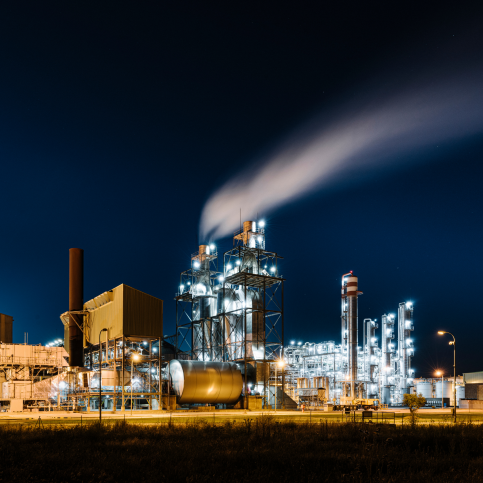Table of Contents
- Introduction to Fat Splitting
- What is Fat Splitting?
- How the Fat Splitting Process Works
- Hydrolysis Reaction
- Separation of Fatty Acids and Glycerol
- Industrial Applications of the End Products
- Key Applications of Fat Splitting
- Soap and Detergent Manufacturing
- Biodiesel Production
- Cosmetics and Pharmaceuticals
- The Industrial Significance of Fat Splitting
- Technoilogy’s Expertise in Fat Splitting Technology
- Conclusion
Introduction to Fat Splitting
Fat splitting is a crucial process in oil and fat refining, breaking down triglycerides into fatty acids and glycerol. This chemical transformation plays a fundamental role in multiple industries, including soap manufacturing, biofuel production, and pharmaceutical formulations.
As industries move towards more sustainable and efficient processing methods, fat splitting remains an essential technique for maximizing the value of natural fats and oils. By optimizing conversion efficiency, manufacturers can extract high-purity fatty acids and glycerol, ensuring their products meet strict industry standards.
What is Fat Splitting?
Fat splitting, also known as hydrolysis or saponification, is a chemical reaction that converts triglycerides (fats and oils) into free fatty acids and glycerol. This process is widely used in industrial applications, where these components serve as the building blocks for various products, from soaps to biofuels.
This reaction is commonly carried out using water and an alkaline catalyst, ensuring an efficient and controlled breakdown of triglycerides. The resulting fatty acids are widely used in chemical, personal care, and energy sectors, while glycerol plays an important role in cosmetics, pharmaceuticals, and food processing.
How the Fat Splitting Process Works
Hydrolysis Reaction
The fat splitting process begins with hydrolysis, where triglycerides react with water under high temperature and pressure. This reaction is typically enhanced with the use of alkaline catalysts or enzymes, accelerating the breakdown of fat molecules.
The hydrolysis reaction:
Triglyceride + Water → Fatty Acids + Glycerol
Separation of Fatty Acids and Glycerol
Once the triglycerides have been hydrolyzed, the reaction mixture contains a combination of fatty acids and glycerol, along with traces of unreacted water and impurities. These components are then separated using gravity settling or centrifugation, ensuring that both fractions are purified for further use.
- Fatty acids are separated and refined for use in soaps, biodiesel, and industrial chemicals.
- Glycerol is purified through distillation or filtration, making it suitable for cosmetic, pharmaceutical, and food-grade applications.
Industrial Applications of the End Products
The purified fatty acids and glycerol are then processed further depending on their intended industrial applications. While fatty acids serve as raw materials in chemical and energy production, glycerol is widely used in moisturizing formulations, food products, and medical applications.
Key Applications of Fat Splitting
Soap and Detergent Manufacturing
Fat splitting plays a key role in soap production, as fatty acids are the primary cleansing agents in bar soaps, liquid soaps, and detergents. The process ensures that the fatty acids produced are of high purity, improving the lathering and cleansing properties of the final product.
Biodiesel Production
Fatty acids derived from fat splitting are also used in biodiesel production, where they undergo esterification to form methyl esters (biodiesel). This renewable fuel alternative helps reduce carbon emissions and supports the transition to sustainable energy sources.
Cosmetics and Pharmaceuticals
Glycerol, one of the key by-products of fat splitting, is widely used in cosmetic and pharmaceutical formulations due to its moisturizing, stabilizing, and emulsifying properties. It is a common ingredient in:
- Skincare products, providing hydration and texture enhancement.
- Pharmaceutical formulations, serving as a stabilizer in medicines and syrups.
- Food products, acting as a sweetener and preservative in processed foods.
The Industrial Significance of Fat Splitting
Fat splitting is an economically and industrially valuable process, enabling manufacturers to extract maximum utility from natural fats. Its applications extend across cleaning, energy, and personal care sectors, showcasing its versatility and importance in industrial processing.
As the world moves towards greener and more sustainable production methods, fat splitting is evolving, with industries focusing on:
- Improving energy efficiency in fat splitting plants.
- Developing eco-friendly catalysts to reduce chemical waste.
- Enhancing by-product utilization, ensuring that every component of the fat is repurposed.
By continuing to innovate fat splitting processes, industries can meet environmental and economic challenges, ensuring that waste is minimized while production efficiency is maximized.
Technoilogy’s Expertise in Fat Splitting Technology
Technoilogy is a leader in fat splitting solutions, providing high-efficiency hydrolysis systems that enable:
- Optimized fatty acid and glycerol separation, ensuring higher purity levels.
- Energy-efficient processing, reducing operational costs.
- Sustainable production methods, minimizing environmental impact.
With advanced processing technology, Technoilogy helps industries refine and optimize fat splitting operations, ensuring better yields, higher quality, and improved sustainability.
For more information, visit:
Technoilogy Fat Splitting Solutions
Conclusion
Fat splitting is a key process in oil and fat refining, enabling industries to transform raw triglycerides into valuable fatty acids and glycerol. This process supports essential industries, including soap manufacturing, biodiesel production, and pharmaceuticals, ensuring that natural fats are efficiently converted into high-quality, functional components.
With ongoing technological advancements and sustainability initiatives, fat splitting continues to evolve, improving processing efficiency and reducing waste. As industries seek innovative solutions, companies like Technoilogy provide cutting-edge fat splitting technologies, ensuring higher purity, better efficiency, and eco-friendly production methods

